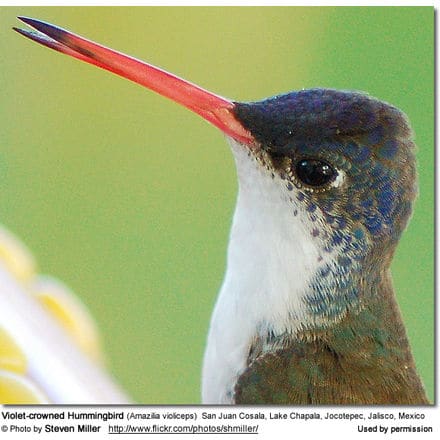Violet-crowned Hummingbirds
Violet-crowned Hummingbird (Leucolia violiceps)
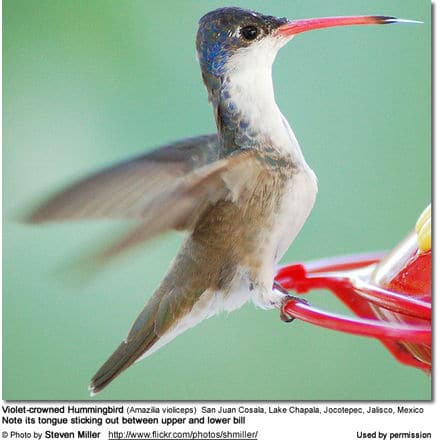
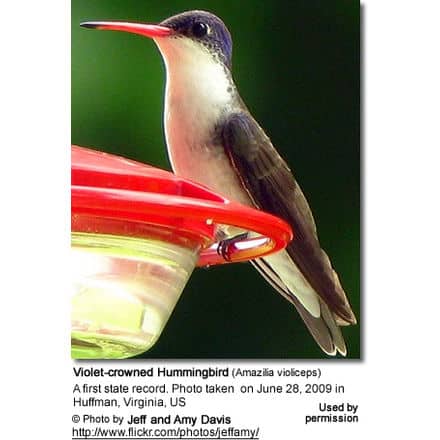
The Violet-crowned Hummingbirds (Amazilia violiceps) – sometimes referred to as Northern Violet-crowned orSalvin’s Hummingbird – occurs primarily in western Mexico and southwestern to south-central United States.
Alternate (Global) Names
Spanish: Amazilia Coronivioleta, Amazilia de Coronilla Violeta, Colibrí Corona Violeta, Colibri Corona-violeta, Colibrí Corona-violeta …French: Ariane à couronne violette, Colibri à couronne violette … Italian: Amazilia corona violetta, Colibrì capoviola … Latin: Agyrtria violiceps, Amazilia salvini, Amazilia verticalis, Amazilia violiceps, Uranomitra salvini … German: Veichenscheitelamazilie, Veilchenscheitelamazilie, Veilchenscheitel-Amazilie, Violettscheitelamazilie … Czech: Kolibrík fialovokorunkatý, kolib?ík fialovokorunkatý … Danish: Violetkronet Snebryst … Finnish: Luumulakkikolibri … Japanese: sumirehachidori … Dutch: Violetkruinkolibrie … Norwegian: Fioletthettekolibri … Polish: szmaragdzik fioletowy … Slovak: kolibrík hnedo-biely … Swedish: Vitbröstad kolibri
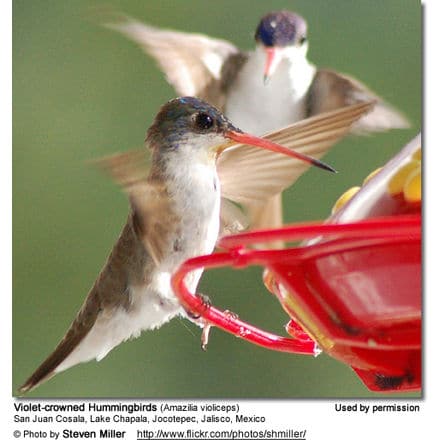
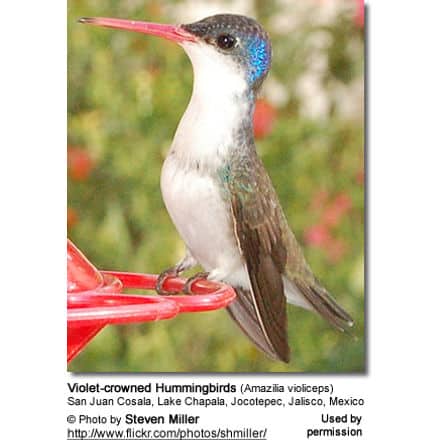
Distribution
The Violet-crowned Hummingbirds is mostly known to be a mountain species that is common in Mexico but is rare and localized in southeastern Arizona, southwestern New Mexico, and western Texas in the United States. Some movements east have been recorded.
The Violet-crowned Hummingbirds are generally found in scrubby open woods, water canyons, along river borders, and partial clearings.
In Mexico, its range extends down the Pacific slope from Sonora through Jalisco to northwestern Oaxaca and in the interior Madrean Highlands from western Chihuahua south through Durango to Oaxaca. In Mexico, they inhabit arid to semiarid scrub, thorn forests, riparian and oak woodlands, as well as parks and gardens.
In the US, their northern (breeding) range includes the arid scrub of southeastern Arizona to southwestern Mexico; outside the breeding season, they may wander to southernmost California and southwest Texas – and in recent years records even exist of them as far east as Virginia (United States eastern coast).
In southeastern Arizona and southwestern New Mexico, they occur in the Madrean Sky Islands – enclaves of Madrean pine-oak woodlands found at higher elevations.
In Texas, they can be found in the extreme west, on the Edward’s Plateau, in south Texas, and occasionally along the coast.
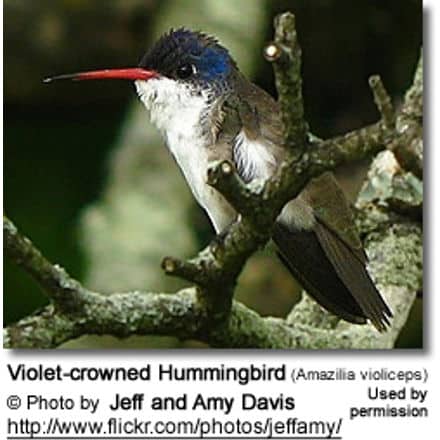
Migratory or Resident?
Some authorities consider this species essentially resident throughout most of its range with local movements; while others list it as being migratory; however, there are numerous records of them both breeding and overwintering in Arizona and other areas.
It seems appropriate to describe this species as a “wanderer” that is currently expanding its range north and eastward.
Subspecies and Distribution:
-
- Amazilia violiceps violiceps (Gould, 1859) – Nominate Race
- Range: Southwestern Mexico.
- Amazilia violiceps ellioti (Berlepsch, 1888)
- Range: Extreme southwestern USA to northwestern and central Mexico.
- Amazilia violiceps violiceps (Gould, 1859) – Nominate Race

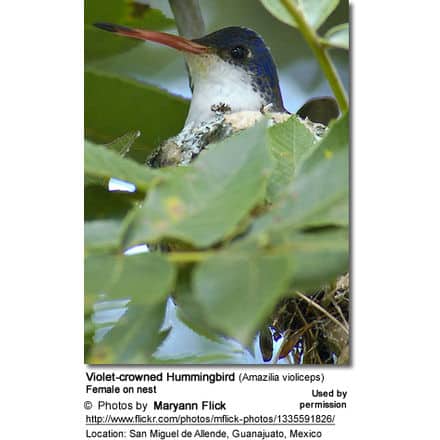
Description
Size:
This medium-sized, long-bodied hummingbird is about 4 inches or 10 cm long.
The slightly larger male weighs 0.2 oz or 5.78 g. The female weighs about 0.18 oz or 5.19 g.
Identifying features:
It is most easily identified by its white under plumage and iridescent bluish-violet crown (from where it gets its name). The back is emerald green. The tail is dark brown/olive green.
The straight and very slender bill is reddish / orangey with a black tip.
Adult females and juveniles resemble the adult male, but the plumage is generally less colorful than that of the male and they have a lighter and greener crown.
Calls / Vocalizations
Their calls are described as loud chatters.
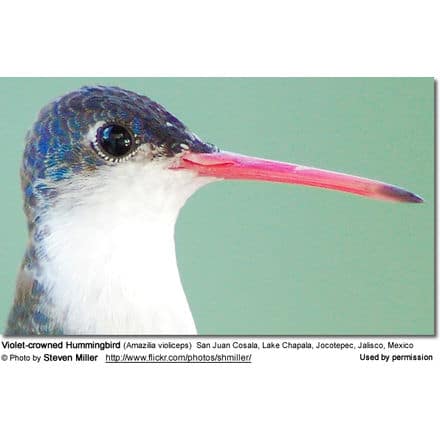
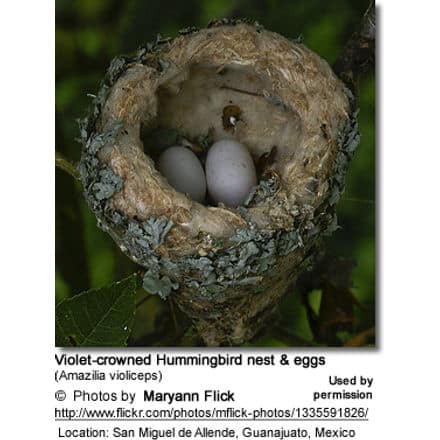
Nesting / Breeding
In southeastern Arizona and southwestern New Mexico, the Violet-crowned Hummingbirds almost exclusively nest in the Arizona sycamore tree (Platanus wrightii), which – in the United States – is limited to narrow strips of land that border creeks.
Hummingbirds are solitary in all aspects of life other than breeding; and the male’s only involvement in the reproductive process is the actual mating with the female. They neither live nor migrate in flocks, and there is no pair bond for this species.
Males court females by flying in a U-shaped pattern in front of them. He will separate from the female immediately after copulation. One male may mate with several females.
In all likelihood, the female will also mate with several males. The males do not participate in choosing the nest location, building the nest, or raising the chicks.
The female is responsible for building the cup-shaped nest out of plant fibers woven together and green moss on the outside for camouflage in a protected location in a shrub, bush, or tree.
She lines the nest with soft plant fibers, animal hair, and feathers down, and strengthens the structure with spider webbing and other sticky material, giving it an elastic quality to allow it to stretch to double its size as the chicks grow and need more room. The nest is typically found on a low, thin horizontal branch.
The average clutch consists of two white eggs, which she incubates alone, while the male defends his territory and the flowers he feeds on. The young are born blind, immobile, and without any down.
The female alone protects and feeds the chicks with regurgitated food (mostly partially digested insects since nectar is an insufficient source of protein for the growing chicks). The female pushes the food down the chicks’ throats with her long bill directly into their stomachs.
As is the case with other hummingbird species, the chicks are brooded only the first week or two and are left alone even on cooler nights after about 12 days – probably due to the small nest size. The chicks leave the nest when they are about 20 days old.
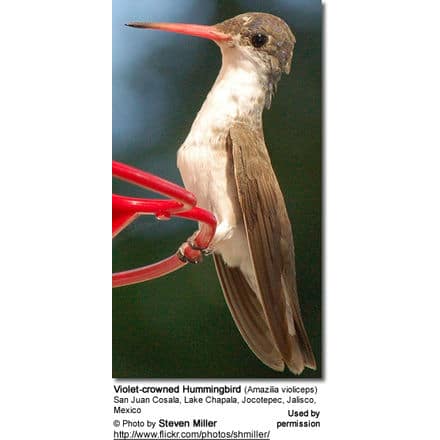
Diet / Feeding
The Violet-crowned Hummingbirds primarily feed on nectar taken from a variety of brightly colored, scented small flowers of trees, herbs, shrubs, and epiphytes. They favor flowers with the highest sugar content (often red-colored and tubular-shaped) and seek out, and aggressively protect, those areas containing flowers with high-energy nectar.
They use their long, extendible, straw-like tongues to retrieve the nectar while hovering with their tails cocked upward as they are licking at the nectar up to 13 times per second. Sometimes they may be seen hanging on the flower while feeding.
Many native and cultivated plants on whose flowers these birds feed heavily rely on them for pollination. The mostly tubular-shaped flowers exclude most bees and butterflies from feeding on them and, subsequently, from pollinating the plants.
In winter, when flowering plants are not readily available, these hummingbirds may drink the sap from holes created by sapsuckers, as a substitute for nectar. They may also visit local hummingbird feeders to retrieve sugar water. They drink out of bird baths or water fountains where they will either hover and sip water as it runs over the edge; or they will perch on the edge and drink – just like all the other birds; except the hummingbirds only remain still for short moments.
They also take some small spiders and insects – important sources of protein particularly needed during the breeding season to ensure the proper development of their offspring. Insects are often caught in flight (hawking); snatched off leaves or branches, or taken from spider webs. A nesting female can capture up to 2,000 insects a day.
Males establish feeding territories, where they aggressively chase away other males as well as large insects – such as bumblebees and hawk moths – that want to feed in their territory. They use aerial flights and intimidating displays to defend their territories.
Hummingbird Metabolism and Survival and Flight Adaption – Interesting Information
